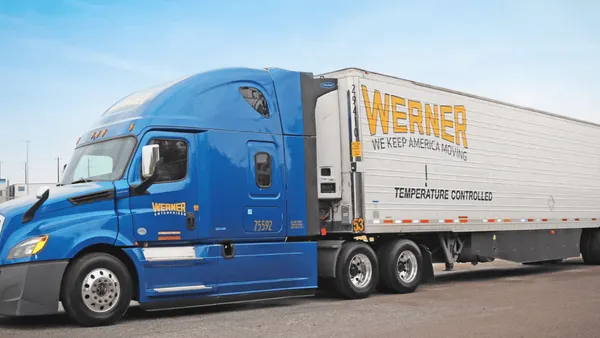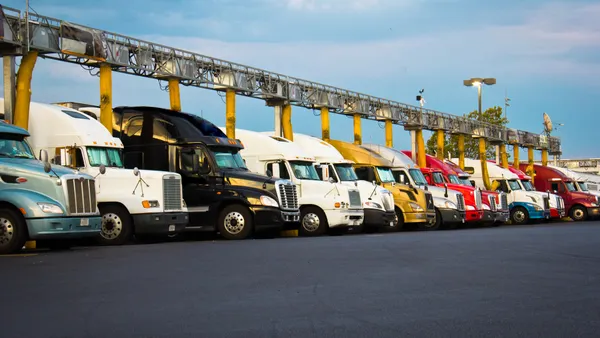Dive Brief:
- Truckload demand is expected to soften in the second half of 2022, but market forces continue to drive higher rates in the near term, according to the April 2022 Cowen/AFS Truckload Freight Index.
- The index, which measures TL rate per mile in the quarter, was 25.2% above the January 2018 baseline in Q1. While that's more than 15 percentage points higher than the year before, shippers may soon get a needed reprieve. The index is expected to plateau in Q2 at 27.1% before a potential decline.
- While spot rates are falling, contract rates should stay elevated as demand for produce shipping climbs in the warmer months, Cowen analysts wrote in a research note. "That said, we acknowledge 2H22 could paint a potentially bleak picture (declining rates) for the TL group," wrote the analysts, referring to 2022's second half.
Per-mile truckload rates expected to plateau in Q2
Dive Insight:
Demand is cooling in 2022 after TL shipments jumped 9.4% YoY in 2021, according to Cowen. This slowdown, in conjunction with smaller fleets bolstering their capacity, has whittled down spot prices, Jason Seidl, senior analyst for airfreight and surface transportation, said in a statement. Larger fleets like Landstar have also added capacity, despite a shortage of trailers in the face of OEM backlogs.
The average spot rate for dry van shipping fell to $3.06 per mile in March, 3 cents lower than in February, according to a DAT news release. The spot reefer rate fell 9 cents, while the flatbed rate increased 26 cents to a record $3.45 per mile. A growing industrial economy is driving flatbed demand, DAT principal analyst Dean Croke said in a blog post.
Contractual pricing power, at least for now, still sits with the carriers across sectors. Rate volatility in the spot market "is a lot more significant than ours," CEO Jim Gattoni said.
"What everybody's struggling with is, if the cycle’s down, how far does the cycle go down?" Gattoni said.
The average contract rate to move dry van freight increased 19 cents to $3.28 per mile in March, surpassing the previous high set in February, according to DAT. Reefer and flatbed rates gained 20 cents and 24 cents, respectively.
"What made March unique is that shippers paid historically high prices to ensure that more of their loads moved under a longer-term contract, reducing their need for trucks on the spot market and causing rates to soften," said Ken Adamo, DAT's chief of analytics, in a statement.
Pricing trends in the second half of the year will be determined in large part by consumer spending, inflation and "demand shifts from pending infrastructure projects," Seidl said.
In LTL, higher fuel surcharges have sparked cost-per-shipment growth. Cowen and AFS' LTL Freight Index is expected to reach an all-time high of 40.9% in Q2 over the January 2018 baseline, following global oil supply disruption and continued high demand.
"With LTL rates at historic highs, shippers are considering alternatives like shipment consolidation, multi-stop truckload and additional warehousing solutions to help manage freight spend," according to a news release on the index.














